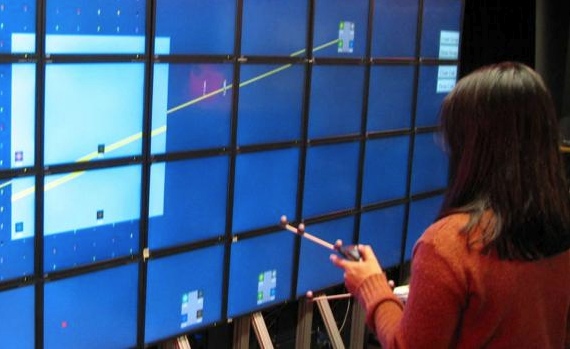
Research in large displays has dramatically increased as multiple monitor configurations have become popular. With this increase, research in 3D interaction techniques (3DITs) has been initiated with hopes of affording greater movement and access to distal information. Unfortunately, most 3DI techniques do not provide the precision necessary for working with large high-resolution displays. In this research, we are evaluating the problems with most 3DITs for high-resolution displays and attempting to design two high-precision techniques based on ray-casting — Zoom for Enhancing Large Display Acuity (ZELDA) and Absolute and Relative Mapping (ARM) Ray-casting.
Problems with Most 3DITs
Pointing is one of the most fundamental classes of 3D manipulation techniques. Within this class, ray-casting is a widely used technique that is simple but effective. With ray-casting, the user points with a virtual ray that defines the direction of pointing. Unfortunately, there are several problems with ray-casting that cause it to lack precision. Natural hand tremor or a person’s inability to keep their hands perfectly still can cause small, unwanted movements in ray-casting. The Heisenberg effect, the effect which causes a person’s hand to move a held device when pressing a button on that device, causes unwanted movements in ray-casting at a very critical instance, when the user is attempting to select something. Other issues with ray-casting include mapping varying with distance, no parkability, and no supporting surface.
Zoom for Enhancing Large Display Acuity (ZELDA)
ZELDA is a bimanual interface designed on the zooming metaphor. The dominant hand controls the cursor and performs basic interactions while the non-dominant hand controls a zoom window that displays the underlying content in greater detail based on a zoom factor. For example, with a zoom window of 1000 by 1000 pixels and a zoom factor of 5, an underlying area of 200 by 200 pixels is displayed five times larger than normal within the window while the remaining underlying area is occluded by the zoom window. ZELDA overcomes many of the problems with ray-casting by making everything larger and therefore decreasing the effects of small, unwanted movements caused by natural hand tremors and the Heisenberg effect. Absolute and Relative Mapping (ARM) Ray-casting ARM Ray-casting is a bimanual interface that utilizes relative mapping. The non-dominant hand allows the user to switch between absolute mapping (standard ray-casting) and relative mapping while the dominant hand specifies the pointing direction. When relative mapping is activated, the current ray-casting intersection point is saved as the relative mapping origin. Any further intersections are then processed as vectors from this origin. By scaling down these vectors, we effectively map standard ray-casting into a smaller defined area of interaction. ARM Ray-casting overcomes many of the problems with ray-casting by mapping ray-casting into a smaller defined area of interaction and therefore decreasing the effects of small, unwanted movements caused by natural hand tremors and the Heisenberg effect.
Journal Articles
A human motor behavior model for distal pointing tasks Journal Article
In: International Journal of Human-Computer Studies, vol. 68, no. 10, pp. 603 - 615, 2010, ISSN: 10715819.
Conferences
Tech-note: rapMenu: Remote Menu Selection using Freehand Gestural Input Conference
Proceedings of the IEEE Symposium on 3D User Interfaces, 2008.

